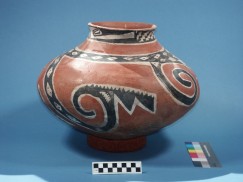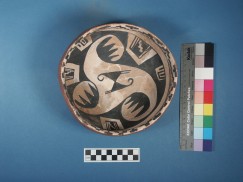- Home
- >
- Preservation Archaeology Blog
- >
- Salado polychrome pottery, part 2
 |
By Deborah L. Huntley, Preservation Archaeologist
|
A major part of our research at Mule Creek—and in the Upper Gila region in general—is to identify compositional and stylistic variability in Salado polychrome pottery (also known as Roosevelt Red Ware) through time and across space. We are using these data to track processes of migration, population coalescence, and long-distance interaction in the study area. I talked about typology in my previous post; today I’ll talk about style.

Archaeologists use the term style to describe the particular way an item is decorated or made. In the case of pottery, style can be a visual characteristic—incorporating a certain color scheme or layout or repeated pattern—known as design style. It may also be may be a technological characteristic, such as the clay recipe used by an individual or group of potters. Archaeologists assume that styles had meaning to their creators.
In her definitive study of Salado polychrome pottery published in 1994, Dr. Patricia Crown pointed out that this ware was one of the most widely distributed in all of Southwestern prehistory. Salado polychrome bowls and jars were made in a number of different regions and decorated using a variety of design styles. These design styles are seen on other types of Southwestern decorated pottery. For example, the Pinedale style seen on many Salado polychromes is common on White Mountain Red Ware and Cibola White Ware from east-central Arizona and west-central New Mexico.

Crown linked the popularity of Salado polychrome pottery with the florescence of a Southwest regional cult, a religious movement associated with rain, fertility, and community well-being that had deep roots among Southwestern groups. Some examples of particular design motifs and icons that express this ideology are serpents (both with and without plumes or horns; see photo 1), clouds, lightning, feathers, flowers, and birds (see photo 2).
We have yet to identify strong regional patterning in design motifs or iconography among sites in the Upper Gila study area. That is, potters from individual villages or river valleys appear to have had no clear local preference for particular suites of icons. This agrees with the results from Crown’s study and supports her interpretation that Salado polychrome pottery served to integrate diverse social groups.